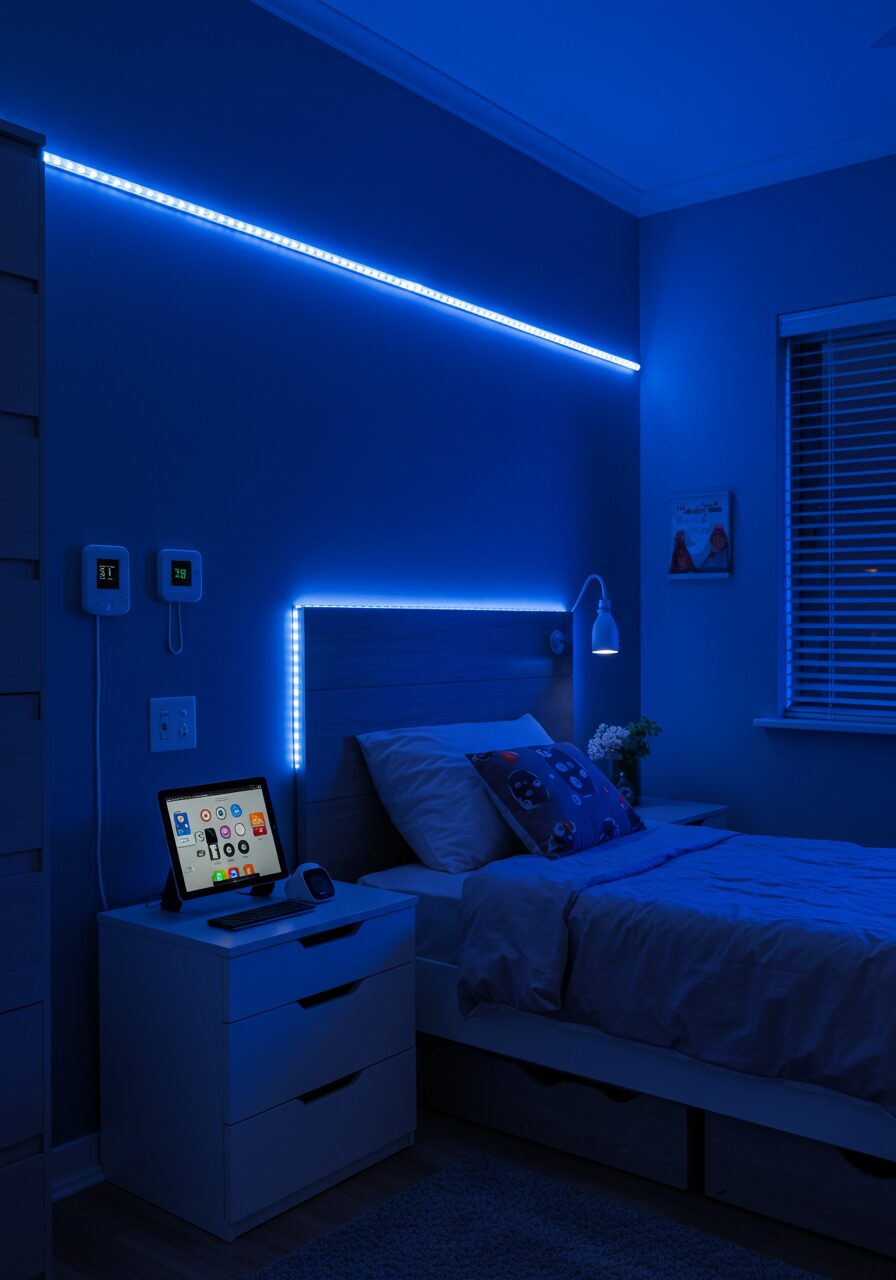Creating the perfect bedroom for a teenage boy requires balancing style, functionality, and personal expression.
Today’s teens crave spaces that reflect their evolving personalities while providing comfort for studying, relaxing, and socializing with friends.
Modern teen bedrooms have moved far beyond basic furniture arrangements to become sophisticated sanctuaries that grow with their occupants.
The key to designing a successful teen boy’s bedroom lies in understanding that this space serves multiple purposes – it’s a study zone, entertainment hub, and personal retreat all rolled into one.
Modern Teen Boy Bedroom Ideas
Whether your teen gravitates toward minimalist aesthetics, bold industrial designs, or tech-savvy setups, the right combination of furniture, color schemes, and accessories can transform any room into a stylish haven.
These 14 modern bedroom ideas showcase innovative approaches to teen bedroom design, offering inspiration for creating spaces that are both trendy and timeless, ensuring your teenager feels comfortable and confident in their personal domain.
1. Industrial Chic with Exposed Elements
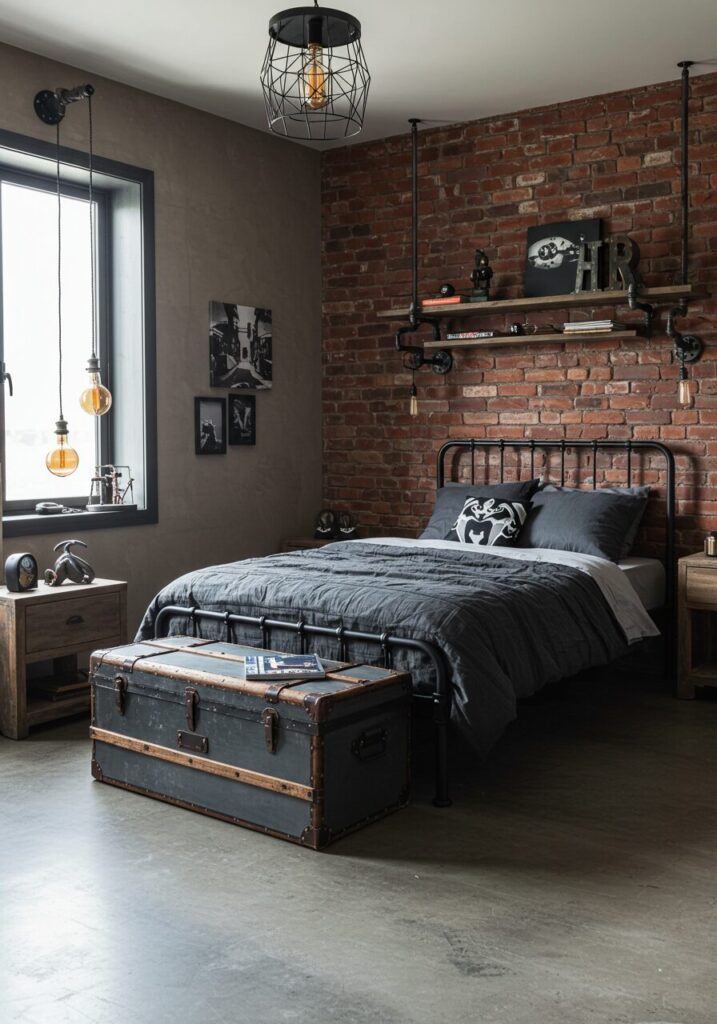
Industrial design brings raw sophistication to teen bedrooms through exposed brick walls, metal fixtures, and weathered wood accents. This aesthetic combines masculine appeal with urban edge, creating a space that feels both mature and contemporary.
Dark color palettes featuring charcoal, rust, and deep browns establish the foundation, while Edison bulb lighting and metal pipe shelving add authentic industrial touches. The beauty of this style lies in its ability to incorporate vintage finds alongside modern technology seamlessly.
Storage solutions like metal lockers and vintage trunks serve dual purposes as functional furniture and design statements. Wire mesh organizers and industrial-style desk lamps complete the look while maintaining practical utility.
A well-executed industrial bedroom feels like a sophisticated loft apartment, giving teens a sense of grown-up independence. The durability of industrial materials also means this design can withstand the wear and tear of teenage life.
I’ve found that incorporating one statement industrial piece, like a metal bed frame or exposed light fixture, can anchor the entire aesthetic without overwhelming the space.
2. Minimalist Monochrome Magic
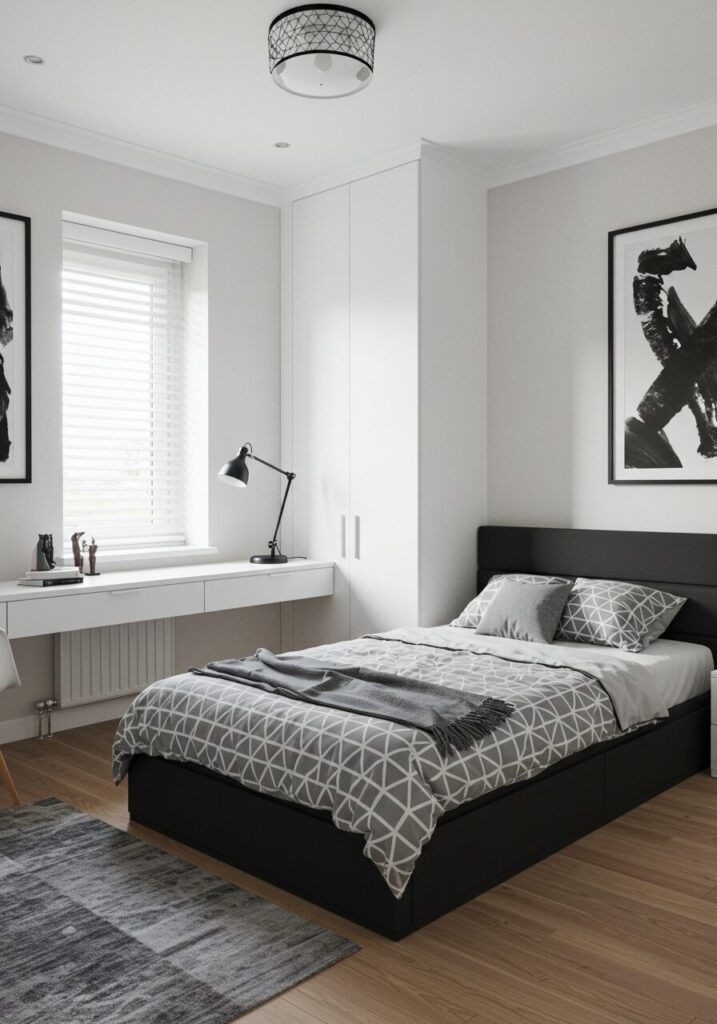
Clean lines and clutter-free surfaces define the minimalist approach, creating calming environments that promote focus and relaxation. This design philosophy emphasizes quality over quantity, featuring carefully selected pieces that serve both form and function.
A monochrome palette of whites, grays, and blacks creates visual cohesion while allowing texture and shape to take center stage. Simple geometric patterns in bedding or wall art add interest without creating visual chaos.
Built-in storage solutions and multi-functional furniture pieces maintain the clean aesthetic while providing necessary organization. Hidden compartments and sleek wardrobes keep personal items out of sight but easily accessible.
The minimalist approach teaches valuable lessons about intentional living and helps teens develop appreciation for well-designed, quality pieces. This timeless style adapts easily as tastes evolve through the teenage years.
Pro Tip: Start with a neutral base and add personality through a few carefully chosen accessories that can be easily changed as interests develop.
3. Gaming Paradise Setup

Modern gaming setups require dedicated spaces that accommodate multiple screens, gaming consoles, and comfortable seating for extended play sessions. This bedroom concept integrates gaming equipment seamlessly into the overall design aesthetic.
Custom-built desk configurations can house multiple monitors while providing ample surface area for keyboards, controllers, and other accessories. RGB lighting systems create immersive atmospheres that can be adjusted based on gaming moods or activities.
Ergonomic gaming chairs and proper lighting reduce eye strain and physical discomfort during long gaming sessions. Cable management systems keep the space organized and prevent tangled wires from creating visual clutter.
Sound-absorbing materials like acoustic panels or thick curtains help contain gaming noise while creating a more professional esports-inspired environment. Strategic placement of gaming memorabilia and collectibles personalizes the space.
Note: Investing in quality ergonomic furniture prevents long-term physical issues and actually improves gaming performance through better comfort and focus.
4. Urban Loft Aesthetic
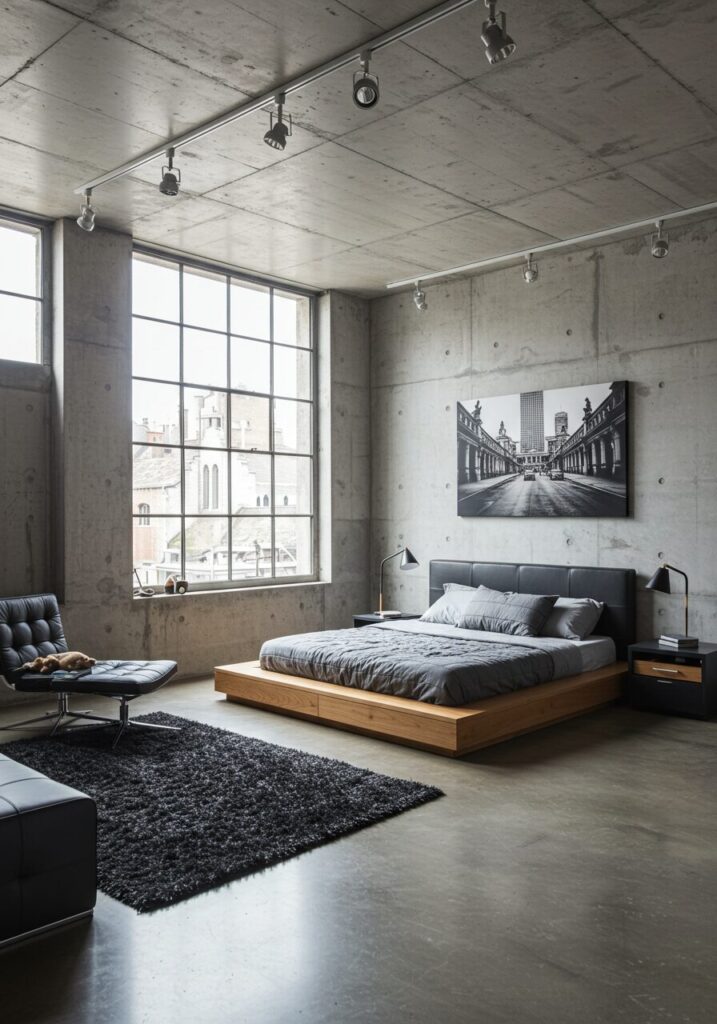
High ceilings, large windows, and open floor plans characterize the urban loft look, creating spacious feeling environments even in smaller bedrooms. This style celebrates architectural features while incorporating modern furnishings and contemporary art.
Concrete accents, whether through actual materials or concrete-effect finishes, provide industrial foundation elements that ground the sophisticated urban aesthetic. Large-scale artwork and photography create focal points that draw the eye upward.
Strategic lighting design includes track lighting, floor lamps, and pendant fixtures that can be adjusted for different activities and moods throughout the day. Multiple light sources prevent harsh shadows while creating ambient atmosphere.
The loft aesthetic encourages creative furniture arrangements that define different zones within the bedroom space. Platform beds, modular seating, and moveable storage pieces offer flexibility as needs change.
Contemporary urban lofts feel sophisticated and mature, helping teens develop appreciation for architectural design and spatial relationships that will serve them well in future living situations.
5. Tech-Forward Smart Room
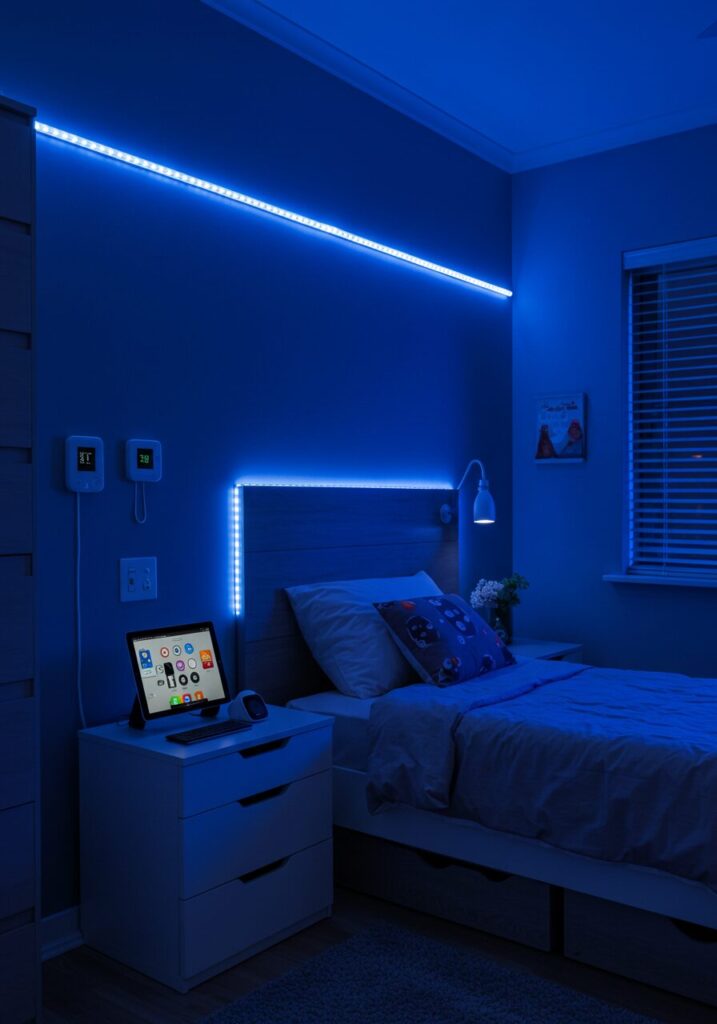
Integration of smart technology transforms bedrooms into connected environments that respond to voice commands, automated schedules, and personal preferences. This approach appeals to tech-savvy teens who appreciate innovation and convenience.
Smart lighting systems allow for custom color schemes, brightness levels, and automated schedules that support healthy sleep patterns. Voice-controlled speakers and smart displays provide entertainment and information access without cluttering surfaces.
Wireless charging stations built into nightstands and desks keep devices powered while maintaining clean aesthetics. Smart thermostats and air quality monitors create optimal sleeping and studying conditions automatically.
Hidden wiring and seamless integration ensure that technology enhances rather than dominates the visual design. Regular software updates and security measures protect privacy while maintaining functionality.
The smart room concept prepares teens for increasingly connected future living environments while teaching them about responsible technology use and digital privacy considerations.
Tip: Start with one or two smart devices and gradually build the system to avoid overwhelming complexity and ensure all family members can operate the technology comfortably.
6. Athletic and Sports-Inspired

Sports-themed bedrooms celebrate athletic achievements while maintaining sophisticated design standards that won’t feel childish as teens mature. This approach balances team loyalty with contemporary styling and functional storage needs.
Strategic display of sports memorabilia, trophies, and equipment creates personal museums that tell the story of athletic journeys and achievements. Shadow boxes and floating shelves provide organized presentation options for collectibles.
Color schemes inspired by favorite teams can be incorporated through bedding, wall accents, and accessories without overwhelming the space. Neutral backgrounds allow team colors to pop while maintaining design flexibility.
Functional elements like equipment storage, uniform organization, and gear maintenance areas support active lifestyles. Built-in cubbies and specialized storage solutions keep sports equipment organized and easily accessible.
Quality sports photography and vintage athletic posters elevate the aesthetic beyond typical fan caves, creating spaces that feel mature and intentionally designed rather than simply decorated with team merchandise.
7. Music Studio Vibes
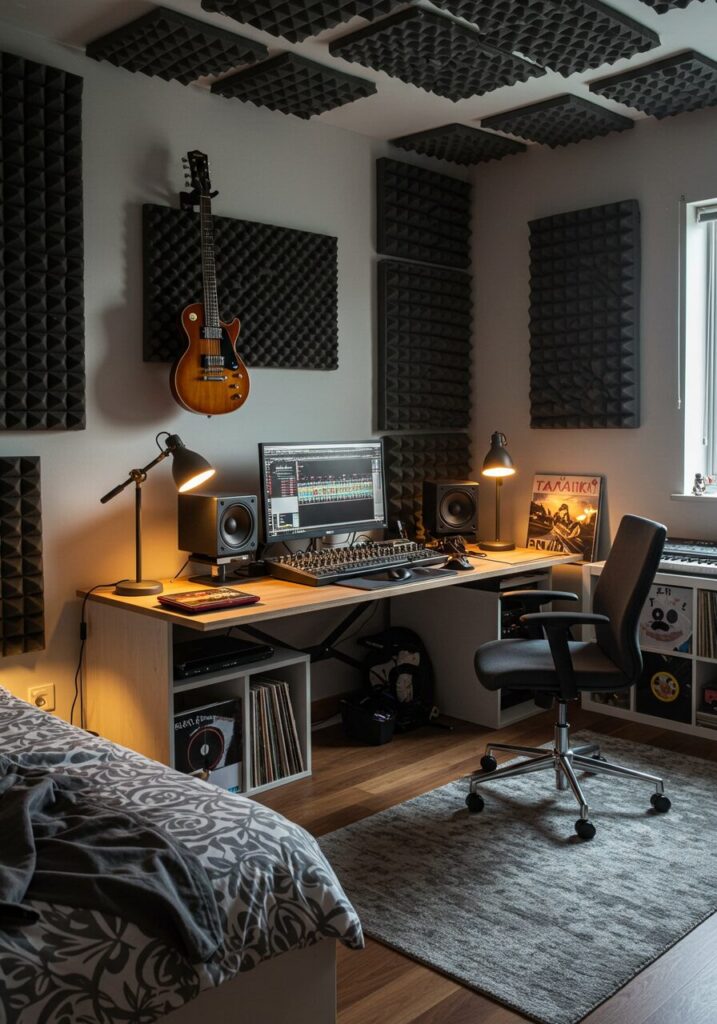
Bedrooms designed around musical interests create inspiring environments for practice, composition, and listening while maintaining acoustic considerations for household harmony. This concept integrates instruments and equipment as design elements rather than afterthoughts.
Acoustic treatment through stylish panels, thick rugs, and sound-absorbing materials reduces noise transmission while improving the room’s audio quality for both playing and listening. Strategic placement prevents sound issues without sacrificing aesthetics.
Instrument storage and display solutions showcase musical equipment while keeping it easily accessible for practice sessions. Wall mounts, stands, and custom storage maintain organization while treating instruments as sculptural elements.
Recording equipment, audio interfaces, and monitoring speakers can be integrated into desk setups or custom workstations. Cable management and proper ventilation ensure equipment longevity while maintaining clean aesthetics.
The music studio approach encourages creative expression while teaching responsibility for expensive equipment care and maintenance, valuable lessons that extend beyond musical pursuits.
Pro Tip: Invest in quality acoustic treatment early – it improves both the room’s sound quality and relationships with other household members who don’t want to hear late-night practice sessions.
8. Scandinavian Simplicity
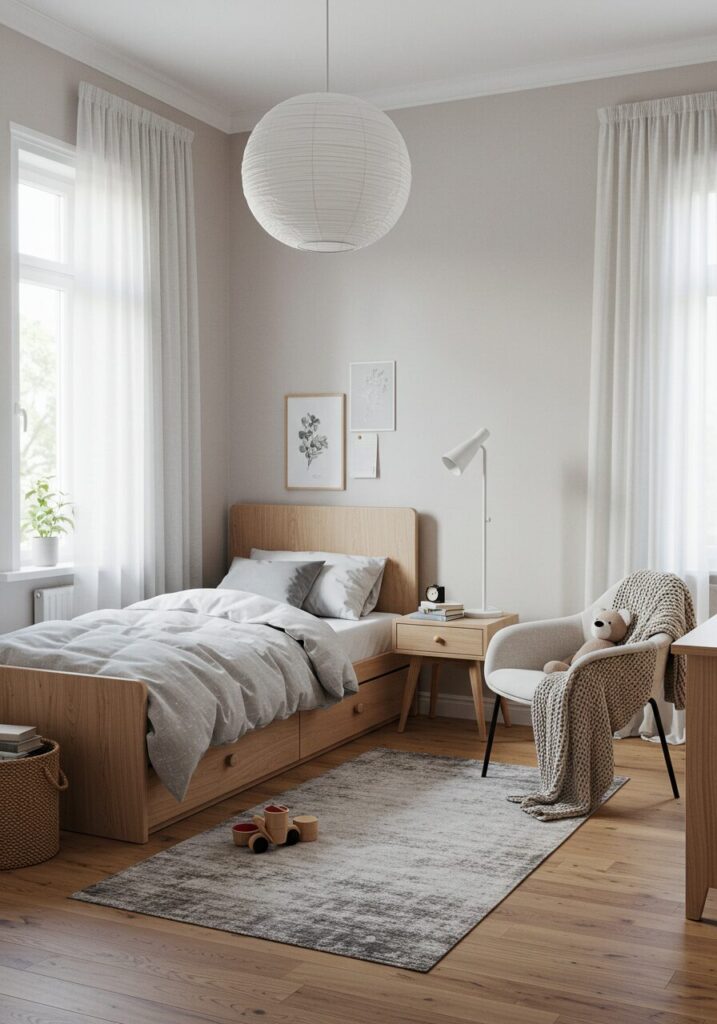
Clean lines, natural materials, and functional design principles define Scandinavian style, creating serene environments that promote rest and concentration. This aesthetic emphasizes quality craftsmanship and sustainable materials over trendy accessories.
Light wood tones, particularly birch and pine, provide warmth while maintaining the clean aesthetic that characterizes Nordic design. White and light gray color palettes maximize natural light and create spacious feelings even in smaller rooms.
Hygge-inspired elements like soft textiles, cozy reading nooks, and warm lighting create inviting atmospheres that encourage relaxation and introspection. Natural fiber rugs and knitted throws add texture without visual complexity.
Functional storage solutions that double as seating or display areas maximize space efficiency while maintaining the uncluttered aesthetic. Multi-purpose furniture pieces reflect Scandinavian values of practicality and sustainability.
This timeless approach creates bedrooms that feel calm and organized, supporting both academic success and emotional well-being through thoughtful environmental design.
9. Dark Academia Aesthetic

Rich colors, vintage-inspired furniture, and literary elements create sophisticated environments that celebrate intellectual pursuits and classical design principles. This aesthetic appeals to teens who appreciate timeless elegance and scholarly atmospheres.
Deep forest greens, burgundy accents, and warm browns establish the color foundation, while brass fixtures and leather-bound book collections add authentic period touches. Vintage or vintage-inspired furniture pieces create character and visual interest.
Built-in or styled bookshelves become focal points that showcase literary collections and academic achievements. Vintage globes, classic desk accessories, and quality writing instruments support the scholarly atmosphere while providing functional utility.
Layered lighting through table lamps, floor lamps, and pendant fixtures creates warm, inviting environments perfect for reading and studying. Rich textiles like velvet pillows and wool throws add comfort and luxury.
The dark academia aesthetic encourages appreciation for literature, history, and intellectual pursuits while creating environments that feel both sophisticated and welcoming to friends and family members.
10. Bohemian Modern Fusion
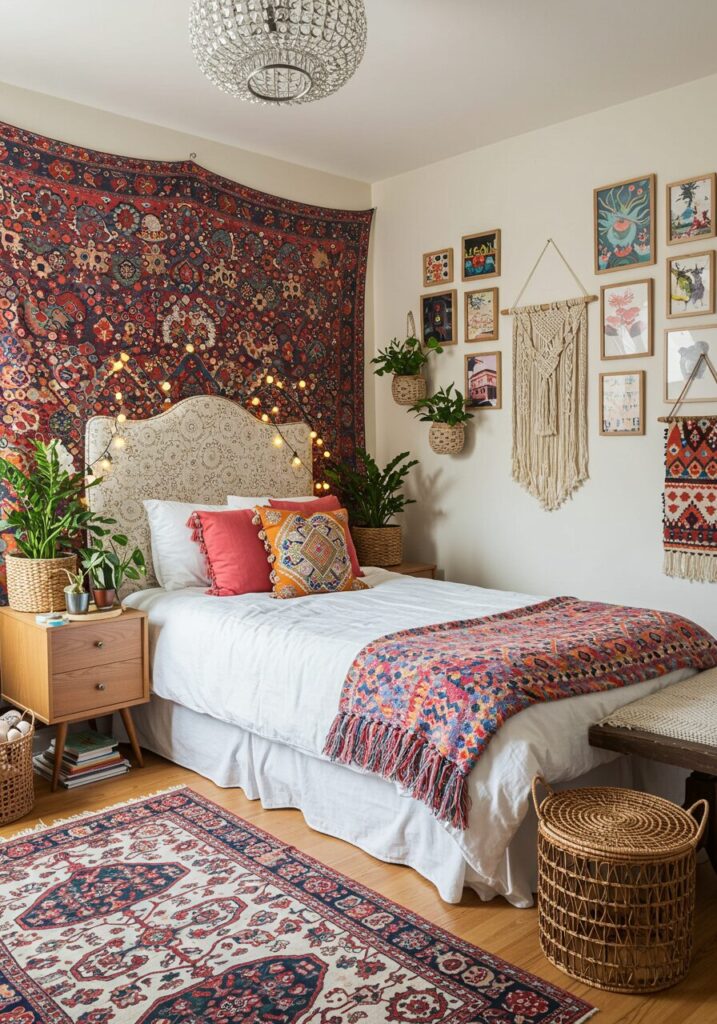
Eclectic patterns, global textiles, and artistic elements create vibrant environments that celebrate creativity and cultural diversity. This style balances bohemian freedom with modern functionality, avoiding cluttered or chaotic aesthetics.
Layered textiles from different cultural traditions add visual interest and cultural education opportunities. Tapestries, throw rugs, and patterned pillows create cozy atmospheres while introducing global design perspectives and artistic traditions.
Natural elements like plants, woven baskets, and wooden accents bring organic textures that soften modern furniture lines. Macrame wall hangings and ceramic accessories add handcrafted touches that celebrate artisanal skills.
Gallery walls featuring diverse artwork, photography, and cultural artifacts create personal museums that reflect individual interests and experiences. Mixed media pieces and student artwork can be integrated alongside professional pieces.
This approach encourages cultural appreciation and artistic expression while maintaining the functionality needed for academic success and daily living requirements.
Note: The key to successful bohemian design is curation – choose pieces that genuinely speak to you rather than just following trends, creating authentic personal expression.
11. Future-Forward Design
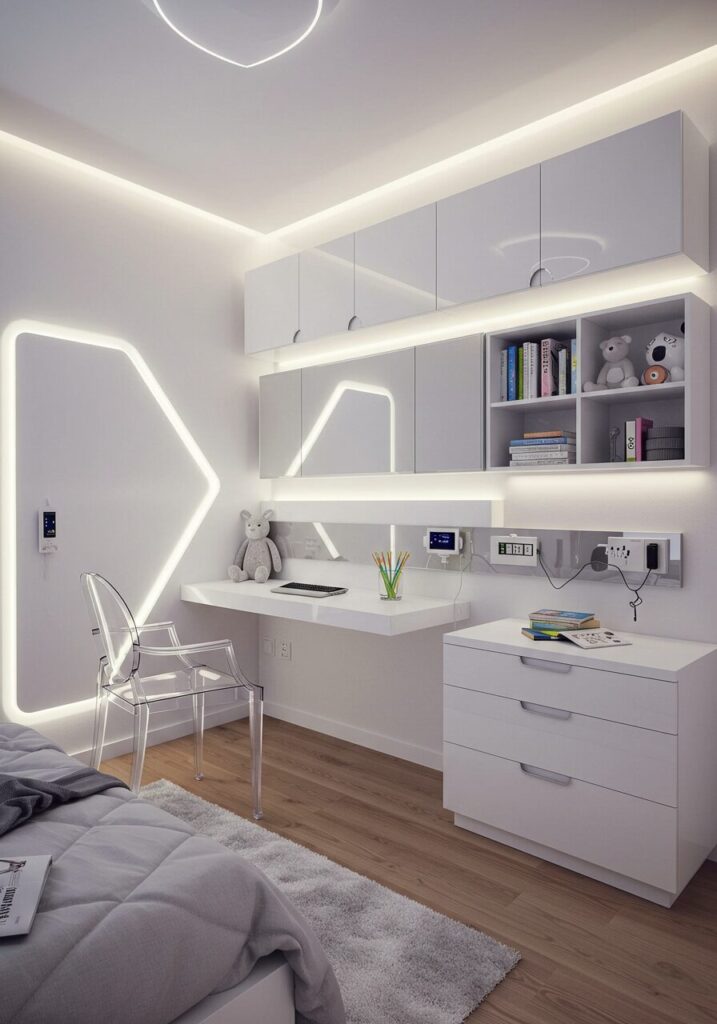
Sleek lines, innovative materials, and cutting-edge aesthetics create environments that feel like they belong in the next decade. This approach appeals to teens who are excited about technology, innovation, and forward-thinking design principles.
LED strip lighting and programmable color systems create customizable atmospheres that can adapt to different activities and moods throughout the day. Smart mirrors, touch-activated surfaces, and gesture-controlled elements add interactive functionality.
Furniture with clean geometric shapes and unexpected material combinations create visual interest while maintaining functionality. Transparent elements like acrylic chairs or glass desks create spacious feelings and highlight architectural features.
Modular and transformable furniture pieces adapt to changing needs and space requirements. Hidden storage and multi-functional elements maximize efficiency while maintaining the clean aesthetic that defines futuristic design.
This style prepares teens for increasingly innovative living environments while encouraging appreciation for cutting-edge design and technological integration in daily life.
12. Vintage Revival Charm
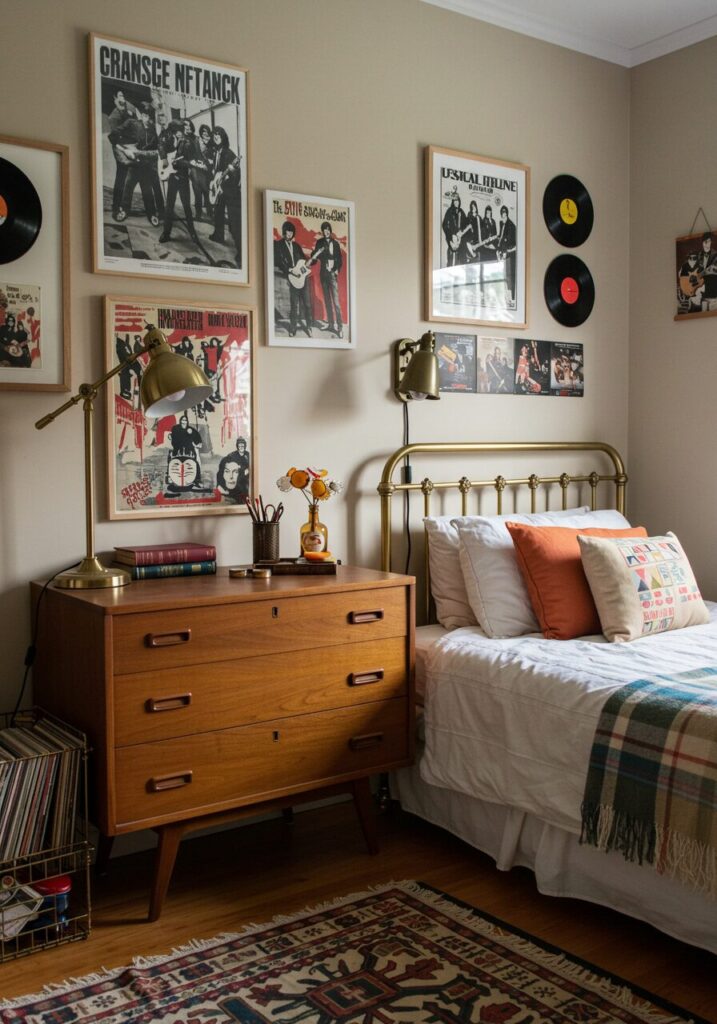
Carefully curated vintage pieces mixed with modern conveniences create bedrooms that celebrate design history while meeting contemporary functionality needs. This approach teaches appreciation for quality craftsmanship and sustainable consumption practices.
Authentic vintage furniture pieces like mid-century modern dressers or retro desks serve as focal points while providing practical storage and workspace solutions. Restored rather than reproduced pieces offer unique character and environmental benefits.
Vintage textiles, artwork, and accessories add personality and historical context while creating conversation pieces that reflect individual interests and family heritage. Thrift store finds and family heirlooms can be integrated thoughtfully.
Modern technology can be incorporated discreetly to maintain vintage aesthetics while providing contemporary functionality. Hidden charging stations and wireless technology maintain period authenticity while meeting current needs.
The vintage approach encourages thoughtful consumption and appreciation for quality design that transcends fleeting trends, valuable lessons for environmentally conscious future living.
Tip: Mix vintage pieces from different eras rather than trying to recreate one specific time period – this creates more interesting and personal design stories.
13. Artistic Creative Studio
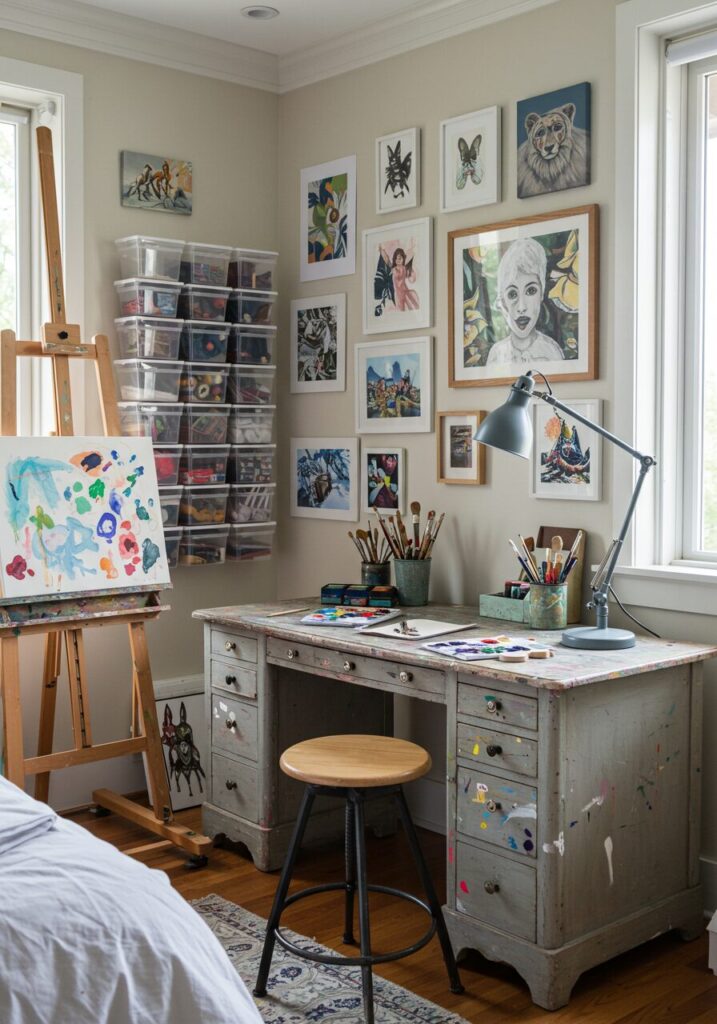
Bedrooms designed to support and showcase artistic pursuits create inspiring environments that encourage creative expression while maintaining organization for various art supplies and ongoing projects. This concept treats the bedroom as both living and working space.
Dedicated workspace areas with proper lighting, ventilation, and storage support various artistic mediums from digital design to traditional painting and drawing. Adjustable lighting and ergonomic seating prevent physical strain during extended creative sessions.
Gallery walls and display systems showcase finished artwork while providing motivation and inspiration for future projects. Rotating display systems allow for regular updates and prevent visual stagnation.
Organized storage solutions for art supplies, works in progress, and finished pieces maintain functionality while keeping materials easily accessible. Clear containers and labeled systems support creative workflows without hindering artistic spontaneity.
This approach validates artistic pursuits as legitimate and important while teaching organizational skills that support creative productivity and professional development in artistic fields.
14. Cozy Reading Retreat
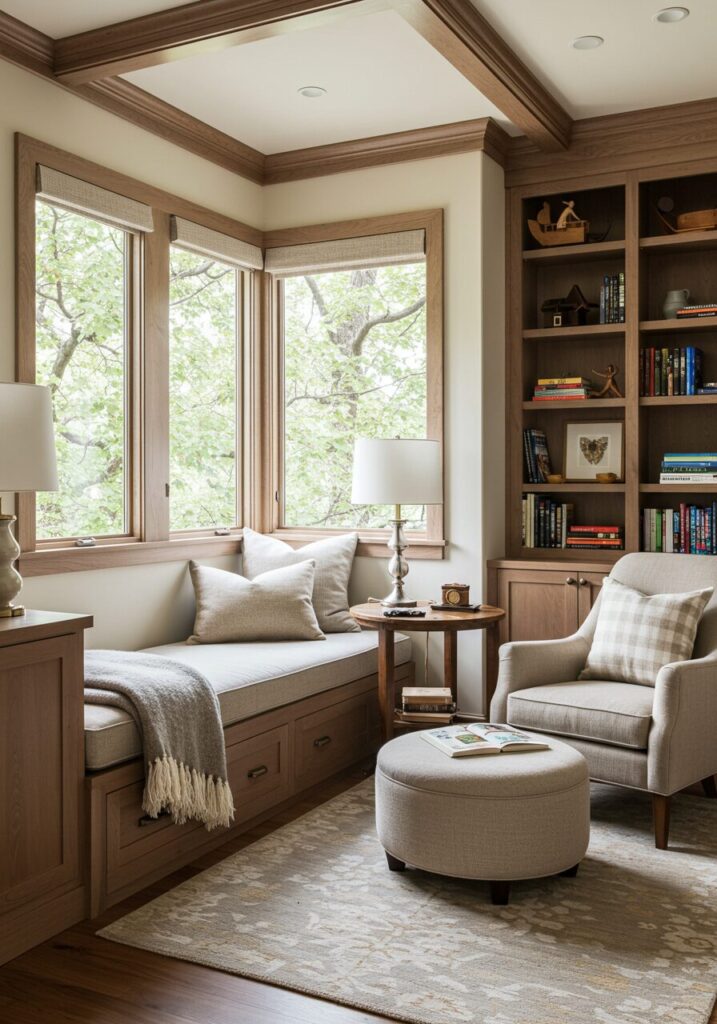
Comfortable seating, warm lighting, and organized book storage create intimate environments perfect for reading, studying, and quiet reflection. This design prioritizes comfort and tranquility while maintaining style and functionality.
Reading nooks with comfortable seating, good lighting, and convenient book storage create dedicated spaces for literary pursuits. Window seats, comfortable armchairs, or built-in benches provide options for different room configurations and personal preferences.
Warm lighting through multiple sources prevents eye strain while creating cozy atmospheres conducive to extended reading sessions. Task lighting, ambient lighting, and natural light work together to support different activities throughout the day.
Personal libraries organized by genre, author, or personal preference become design elements that reflect individual interests and intellectual development. Built-in shelving or attractive bookcases showcase collections while keeping them easily accessible.
Soft textiles like throw blankets, comfortable pillows, and area rugs create inviting environments that encourage relaxation and contemplation, supporting both academic success and personal growth through literature.
Pro Tip: Create multiple reading spots with different lighting conditions – bright task lighting for textbooks and softer ambient lighting for leisure reading – to support different types of reading throughout the day.
Conclusion
Designing a modern teen boy’s bedroom requires balancing personal expression with practical functionality, creating spaces that support academic success, social connections, and individual growth.
These 14 design concepts demonstrate that teen bedrooms can be sophisticated, stylish, and age-appropriate while reflecting unique personalities and interests.
The key lies in choosing design elements that can evolve with changing tastes and needs, investing in quality pieces that will last through the teenage years and beyond.
Whether your teen gravitates toward minimalist aesthetics, industrial chic, or creative studio vibes, successful bedroom design begins with understanding how the space will be used and what activities it needs to support.
By incorporating smart storage solutions, flexible furniture arrangements, and personal touches that reflect individual interests, you can create environments that feel both current and timeless, supporting your teenager’s journey toward independence while maintaining the comfort and functionality essential for this important developmental stage.
